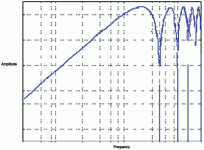Just a little question.
Does a Golden Ratio ratio speaker box have greater capabilities for creating micro-details?
Or does it mostly depend on the speaker element used?
Does the volume on the speaker box affect the ability to create micro-details?
Does the tuning on the speaker box affect the ability to create micro-details?
Does a Golden Ratio ratio speaker box have greater capabilities for creating micro-details?
Or does it mostly depend on the speaker element used?
Does the volume on the speaker box affect the ability to create micro-details?
Does the tuning on the speaker box affect the ability to create micro-details?
I'd consider a golden ratio to be a starting point. The last speakers that I've made use very cheap drivers, but a design of enclosure to absorb the back wave as much as possible, and to be " dead " - the front is softly mounted to the cabinet in an effort to both isolate the mechanical vibrations emanating from the drivers, and to dampen vibrations in the cabinet, and they are the best speakers that I've made so far, just lacking in ultimate bass extension due to their size. They are very detailed and reproduce tone ( and specifically vocals ) very well.
Here's a few attempts that I've made at absorbing internal waves and vibration, the speakers with the shinny ( 4.5 kg ) lump on top were an attempt at taking vibration directly from the driver magnet ( the black box beneath was also isolated from the lower " ply wood " enclosure by springs and foam. The last three pictures are of my packing case Christmas tree diffuser that I mentioned previously.
Attachments
-
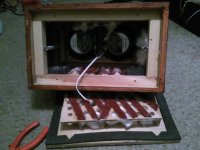 IMG_20200902_202310.jpg331.3 KB · Views: 165
IMG_20200902_202310.jpg331.3 KB · Views: 165 -
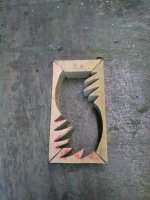 IMG_20200915_093008.jpg535.1 KB · Views: 159
IMG_20200915_093008.jpg535.1 KB · Views: 159 -
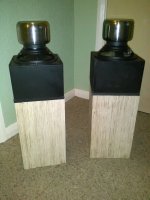 IMG_20210819_203029.jpg467.4 KB · Views: 173
IMG_20210819_203029.jpg467.4 KB · Views: 173 -
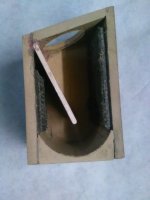 IMG_20211123_132015.jpg364.8 KB · Views: 190
IMG_20211123_132015.jpg364.8 KB · Views: 190 -
 IMG_20220315_082711.jpg309 KB · Views: 171
IMG_20220315_082711.jpg309 KB · Views: 171 -
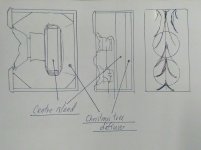 IMG_20220315_082819.jpg1.3 MB · Views: 168
IMG_20220315_082819.jpg1.3 MB · Views: 168 -
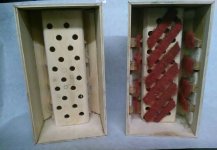 IMG_20220324_084802.jpg396 KB · Views: 162
IMG_20220324_084802.jpg396 KB · Views: 162
Just a little question.
Does a Golden Ratio ratio speaker box have greater capabilities for creating micro-details?
Or does it mostly depend on the speaker element used?
Does the volume on the speaker box affect the ability to create micro-details?
Does the tuning on the speaker box affect the ability to create micro-details?
I have been out of single driver for a while since i sold lowthers. Now i use full range speakers as computer desktop speakers.
When it comes to micro-details, i would assume these are mainly upper mid and treble, say from 1kHz up, depends mostly on the driver construction.
Best box is no box, i use mostly open baffle speakers, recently planar dipole for upper mid and treble. I am very happy about the sound, plenty of micro-details, even i never use this term.
For my next speakers ( " quad triangle cutlery alien on a sub box" ) I'm going to use four small full range drivers, as hopefully four small drivers will be closer to posttonic motion than one big one. Also the triangle ( head ) enclosure should absorb the back wave well.
Attachments
How about a 'meta-material'? I think the KEF idea is basically a quadratic residue diffusor sequence used to create an array of resonators with their freq. equally spread across the spectrum. Maybe similar could be done by making a nice deep diffusor (like RPG Omni-fusor) on the back of the box and adding a bit of damping at the bottom of each well.
![RPG_Diffusor_Systems_HEMIP_2_Hemiffusor_W1_Diffusor_484929[1].jpg RPG_Diffusor_Systems_HEMIP_2_Hemiffusor_W1_Diffusor_484929[1].jpg](https://www.diyaudio.com/community/attachments/rpg_diffusor_systems_hemip_2_hemiffusor_w1_diffusor_484929-1-jpg.1051651/)
'Micro-detail' technically doesn't have any meaning sans clarification on exactly what mechanisms you're referring to, so we need to be a little careful on this front.
Golden (or any other acoustic) ratio simply creates an irrational set of proportions, which can reduce the generation of eigenmodes (standing waves) & thereby potentially mean a cabinet with internal proportions set to that ratio requires a little less damping. Whether that equates to 'better micro-detail' is open to question unless as noted the specific mechanisms being referred to are clarified. Assuming a competent baseline -probably not in most cases, since it shouldn't have any audible effects above the mass-corner frequency or the controlled TL modes through the cone / cap substrates that are how wideband drive units produce the majority of their BW. Ditto if the ratio is applied to the external proportions, although you may (may) have a slightly more benign edge-diffraction profile. The overall dimensions, any edge treatment e.g. chamfers, etc., and the location of the driver on that baffle are all likely to have as much or more impact though. Golden etc. ratios are nice & rarely do any harm, but they aren't a magic bullet or automatically have superiority over alternatives -acoustics is rarely that simple in practice.
Golden (or any other acoustic) ratio simply creates an irrational set of proportions, which can reduce the generation of eigenmodes (standing waves) & thereby potentially mean a cabinet with internal proportions set to that ratio requires a little less damping. Whether that equates to 'better micro-detail' is open to question unless as noted the specific mechanisms being referred to are clarified. Assuming a competent baseline -probably not in most cases, since it shouldn't have any audible effects above the mass-corner frequency or the controlled TL modes through the cone / cap substrates that are how wideband drive units produce the majority of their BW. Ditto if the ratio is applied to the external proportions, although you may (may) have a slightly more benign edge-diffraction profile. The overall dimensions, any edge treatment e.g. chamfers, etc., and the location of the driver on that baffle are all likely to have as much or more impact though. Golden etc. ratios are nice & rarely do any harm, but they aren't a magic bullet or automatically have superiority over alternatives -acoustics is rarely that simple in practice.
Scottmoose
Yes it is a difficult subject.
I find it tricky to describe what I want to achieve. The small nuances in the music.
Give the driver the best conditions to be able to move as easily as possible. Move and quickly stop again.
Maybe OB is the best.
I am now trying to put distances between the driver and the box. 1.5mm I start with. Think it sounds a little more detailed. The level of the base becomes weaker. The base gets a little more articulate after all.
Yes it is a difficult subject.
I find it tricky to describe what I want to achieve. The small nuances in the music.
Give the driver the best conditions to be able to move as easily as possible. Move and quickly stop again.
Maybe OB is the best.
I am now trying to put distances between the driver and the box. 1.5mm I start with. Think it sounds a little more detailed. The level of the base becomes weaker. The base gets a little more articulate after all.
Last edited by a moderator:
Would it be fair to say there are the same number of modes but that their spread changes?which can reduce the generation of eigenmodes (standing waves)
Lower frequencies that are less directional than high frequencies will leak out the gap and cancel at the sides. You are creating a kind of di-pole with a box behind the driver and damping to 'catch' the more direction mid and high frequencies. This is a common way to use di-pole in a room - open baffle di-pole with a thick sound absorber placed behind it.Scottmoose
What have I done when I put a distance between drivern and the box?
One distance (1.5mm) on every screws.
It is a closed box.
Regards
Leif
You probably hear more detail becasue bass output is reduced and also room interaction reduced.
Do you think i get less movement of the cone?Lower frequencies that are less directional than high frequencies will leak out the gap and cancel at the sides. You are creating a kind of di-pole with a box behind the driver and damping to 'catch' the more direction mid and high frequencies. This is a common way to use di-pole in a room - open baffle di-pole with a thick sound absorber placed behind it.
You probably hear more detail becasue bass output is reduced and also room interaction reduced.
View attachment 1051802
Not necessarily. The job of dealing with the rear radiation in a closed box will be handled by the damping material. If damping material is not used then using the golden ratio can not fix the problem on its own.Does a Golden Ratio ratio speaker box have greater capabilities for creating micro-details?
You will get more cone movement when there is an open gap or open baffle because the woofer does not press against air spring inside the closed cabinet. That air inside the closed box is similar as pressing your hand on the driver.Do you think i get less movement of the cone?
Good quality near-field studio monitor (speakers) are designed for exactly this purpose - to reveal small nuances in the music, so that recording / mixing engineers can hear fine details.The small nuances in the music.
So what goes into the design of a good studio monitor? Once you know that, you have a good idea how to make good speakers yourself.
It's not about magic boxes/ stuffing/ speaker mounting. It's mostly about the flattest possible frequency response, along with reasonably well controlled treble dispersion. This seems to come down mostly to finding good drivers, designing a good crossover network, and to a small extent, controlling diffraction from the edges of the enclosure.
Pick drivers with very flat frequency responses within their intended frequency ranges, and you are probably 70% of the way there. Design a really good crossover network, including time delay compensation for the tweeter, and you are 90% of the way there. Get the box volume / port tuning if any right, you are 95% of the way there. The last few percent are from details like rounding box edges to help reduce diffraction problems from the edges of the front panel.
To get the details right, you have to be able to accurately measure frequency responses at every stage. Calculate, build, measure, tweak, repeat. The "measure" stage is where DIY has a huge disadvantage. The pros have tools like very expensive Brüel & Kjær measurement microphones with ruler-flat frequency responses ( https://www.bksv.com/en/transducers/acoustic/microphones/microphone-set ), and access to real anechoic chambers.
At the frequencies where it matters for revealing musical detail, this mostly down to the moving mass of the speaker (Mms)and force constant (BL product). These things are designed into the driver. You have no control over them, other than to buy the right driver in the first place.Give the driver the best conditions to be able to move as easily as possible. Move and quickly stop again.
Remember that the frequency response and transient response are tightly locked together - one of them completely predicts the other. A perfectly flat frequency response equals an infinitely fast transient response (ability to stop and start again). Neither ideal exists in reality - but the flatter the driver response, the better it's transient response will be, and vice versa.
And yet, there isn't a single good quality studio monitor using an open baffle.Maybe OB is the best.
Why is that? Well, open baffles produce disastrously bad bass response, and usually disastrously bad frequency response up through the midrange as well. See attached pic showing predicted frequency response for an ideal (flat response, zero-diameter) speaker mounted in a circular open baffle. The bass rolls off gently starting at quite a high frequency, so there is very little bass. Sound from behind the baffle interferes with sound from the front at multiple frequencies, producing peaks and dips in the frequency response.
(In real life the midrange and HF peaks and dips are less extreme than they are in the simplified mathematical model. But the problem is still quite real. Open baffles do not produce anything close to a flat frequency response.)
Why does OB retain a niche popularity in DIY? I can only guess. My guess is that there are four reasons.
The first one is the obvious one: open baffles are ridiculously simple to build. No carpentry skills necessary.
The second one is that by producing little bass and a slow bass rolloff, they can give the illusion of more clarity elsewhere in the frequency range (IMO this is rather like chopping off your legs to give yourself the illusion that you have lost weight.)
The third is that they avoid "boomy" or "boxy" sounds resulting from poor port tuning or poor damping of internal box acoustic resonances. (But well designed studio monitors don't sound boomy or boxy - it's a matter of a properly designed, stuffed, and tuned enclosure.)
The forth is that some people like the wash of reflected sound coming off the back of the open baffle system, so much that they overlook the tremendous other failings of OB speakers. Other people hate that same sound. In DIY, it is common for a builder to fixate on one single aspect of performance, to the point where they completely overlook massive failings elsewhere.
This is an auditory illusion. Whenever you gently filter off the deep bass, with a slow roll-off, the music sounds more articulate. This became very evident back in the early 1980s when Sony started selling their Walkman cassette players with lightweight over-the-ear headphones. Those headphones .produced the same kind of weak bass, gradually falling away below a quite high frequency. And that gently sloping low frequency response produced the same subjective illusion of more articulate and clear music, if you could overlook the almost complete absence of actual deep bass.The level of the base becomes weaker. The base gets a little more articulate after all.
You can easily hear the opposite end of this same illusion, too, in home theatre systems with the subwoofer level turned up too high. Lots of deep powerful bass, but the resulting sound is muddy and less clear.
-Gnobuddy
Attachments
Does a Golden Ratio ratio speaker box have greater capabilities for creating micro-details?
Maybe. But there are so many other factors. Golden Ratio is an irrational number. Use of other irrational numbers (be careful) one can also get a set of distance ratios that, given the nature of irratoional numbers, will tend to give a “nicer” distribution of side-to-side, front/back, bottom/top waveforms.
Now whether those have any real impact depends on (at a minimum), box ratios (what we are talking here), box type (TL encourages one of those), damping, cone material, box shape, volume, proxomity to internal & external (ie edges) reflections… Is there stuff inside that breaks things up (as shown by cracked case, as the holey braces in my boxes can be used for a secondary purpose, and things like the B&W DM302.

micro-details/DDR requires the driver to not already bury the small detail (TC9 is a good exampel)band the box allowing for the really small stuff to be reproduced. An example is that the more or less constant low-level drone of energy seeping thru an MDF enclosure creates a limit to how much DDR can be acheived.
So golden ratio is certainly interesting and has some very specific aesthetic attributes. So sorta special, but not “god”.

dave
- Home
- Loudspeakers
- Full Range
- Golden Ratio speakers?!
 Please see rule #15. Posts have been cleaned.
Please see rule #15. Posts have been cleaned.
